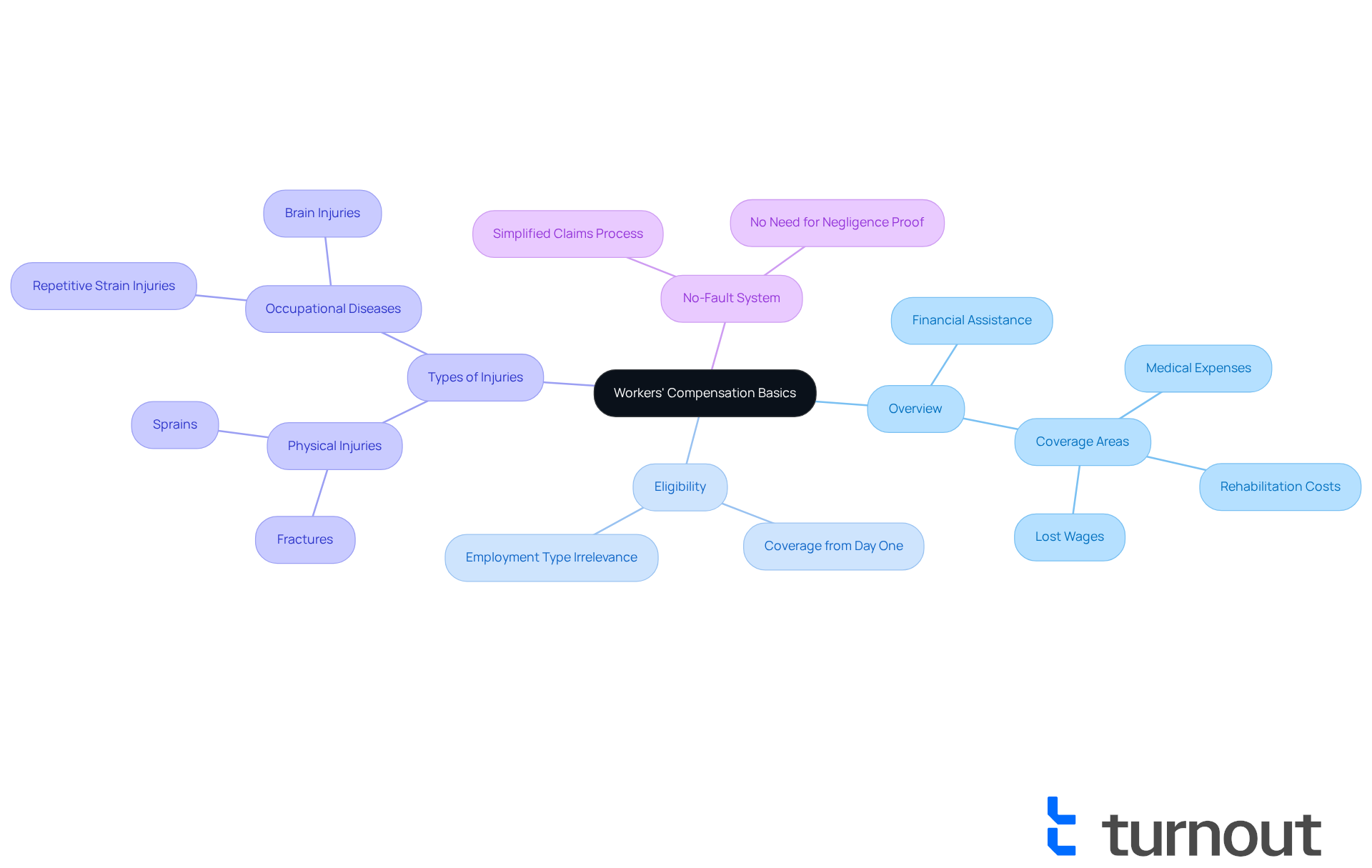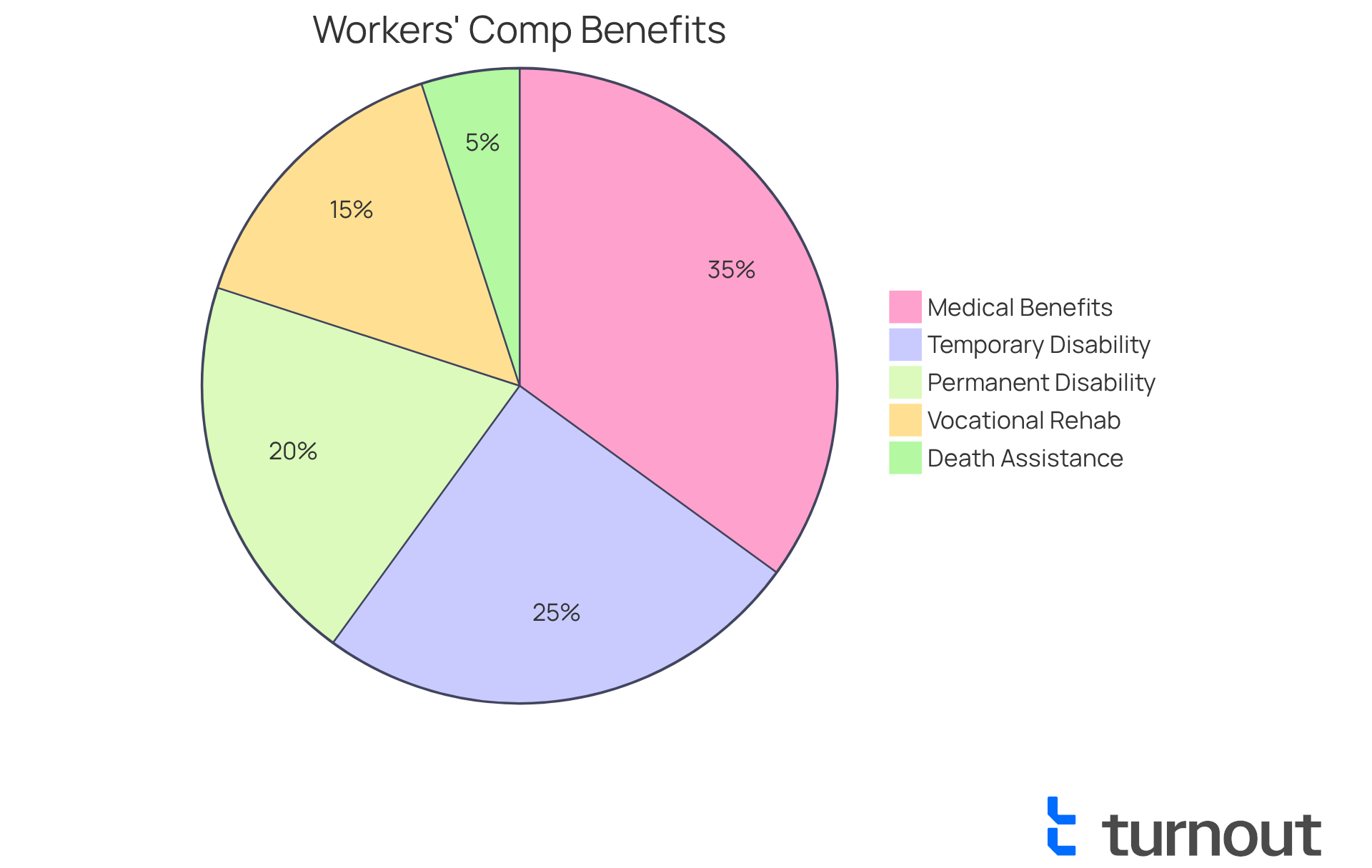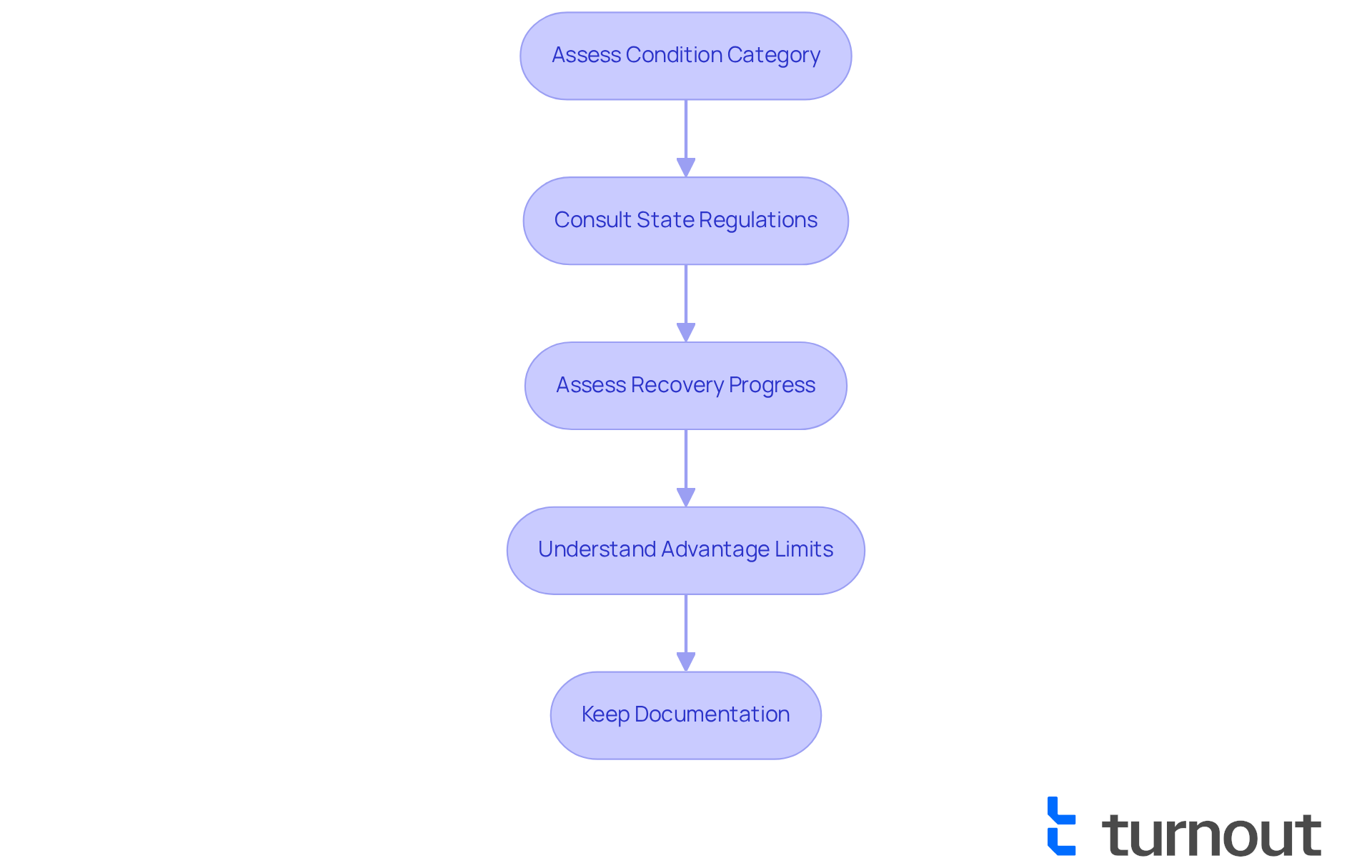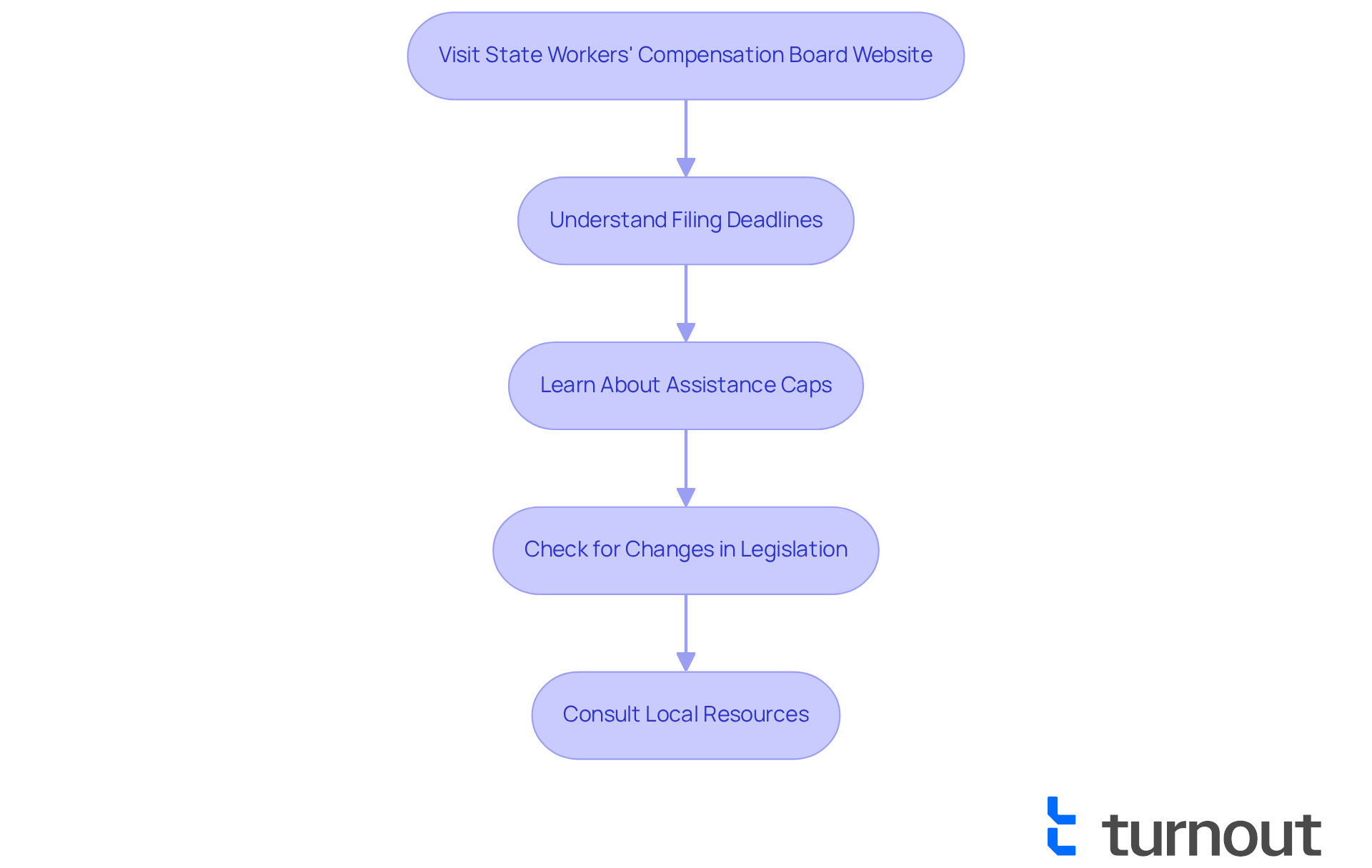Overview
Navigating workers' compensation benefits can often feel overwhelming, especially when it comes to understanding how long assistance will last. Typically, these benefits depend on the type of injury and state regulations, with temporary disability assistance generally lasting up to 104 weeks. We understand that this uncertainty can be stressful.
It's crucial to grasp the specifics of your condition, the state laws that apply, and your recovery journey. This knowledge empowers you to advocate for your needs effectively. Remember, thorough documentation and adherence to state-specific guidelines are vital in this process.
You are not alone in this journey. Many individuals face similar challenges, and seeking support is a positive step forward. If you have questions or need guidance, please reach out—we're here to help you navigate this path with compassion and understanding.
Introduction
Navigating the aftermath of workplace injuries can be overwhelming, and understanding the intricacies of workers' compensation is crucial for employees like you. This essential insurance not only covers medical expenses and lost wages but also serves as a lifeline during challenging recovery periods.
We understand that many individuals may feel uncertain about:
- How long these benefits last
- What factors influence their duration
What steps can you take to ensure you receive the maximum support available?
How do state regulations play a role in this complex landscape?
You're not alone in this journey, and we're here to help you find the answers you need.
Understand Workers' Compensation Basics
Workers' compensation is a vital insurance scheme that provides financial assistance to employees who suffer from work-related accidents or illnesses. It encompasses coverage for medical expenses, rehabilitation costs, and a portion of lost wages. Understanding this coverage is essential, especially when facing challenges related to workplace injuries.
Eligibility: Most employees are covered from their first day on the job, irrespective of their employment type. This extensive coverage ensures that you can access support when you need it most.
Types of Injuries: Benefits extend to both physical injuries, such as fractures or sprains, and occupational diseases, including repetitive strain injuries. This inclusivity highlights the program's commitment to addressing various health issues arising from work.
No-Fault System: Workers' support operates on a no-fault basis, meaning you do not need to establish negligence to qualify for assistance. This system simplifies the claims process, allowing for quicker access to the support you deserve.
We understand that navigating the claims process can feel overwhelming. However, knowing these fundamentals equips you to manage it more effectively. As a testament to the importance of this coverage, approximately 70% of employees in the U.S. are safeguarded by workers' insurance, underscoring its critical role in workplace safety and employee welfare. Remember, you are not alone in this journey, and understanding your rights can empower you to seek the assistance you need.

Explore Types of Workers' Compensation Benefits
Workers' compensation benefits encompass several essential categories designed to support injured employees. We understand that navigating this process can be overwhelming, but Turnout is here to simplify your access to these benefits:
-
Medical Benefits: This covers all necessary medical expenses related to your injury, including hospital visits, surgeries, rehabilitation services, and prescription medications. You won't have to worry about co-pays or deductibles, allowing you to focus on your recovery without financial stress.
-
Temporary Disability Assistance: If you're unable to work due to your injury, this assistance offers wage replacement. Typically, temporary disability payments start within 14 days of the insurance company receiving the medical report and continue until you reach maximum medical improvement or return to work, leading many to ask how long does workman comp last. In 2025, the minimum weekly allowance will rise to $325.00, with the maximum increasing to $1,680.29.
-
Permanent Disability Benefits: If you have lasting impairments impacting your ability to work, these benefits are provided based on the severity of your disability. This ensures that those facing long-term challenges receive the support they need.
-
Vocational Rehabilitation: For workers requiring retraining for another position due to their condition, this support includes job retraining initiatives and educational courses. We’re here to help you regain your footing in the labor market.
-
Death Assistance: These provisions offer support for dependents of individuals who pass away due to a job-related injury or illness. This includes funeral costs and continued financial aid for the family.
Grasping these advantages is essential for successfully maneuvering through the claims process and ensuring you obtain the assistance you require. Turnout can assist you in this journey by providing trained non-lawyer advocates who help clients navigate the complexities of SSD claims and tax relief options. Recent modifications in California's employment injury laws aim to enhance fairness and transparency, providing employees with increased disability payments and better access to information about their rights. It's common to feel uncertain, but employers are now required to provide clearer information about these rights to injured employees, ensuring you are well-informed throughout the process. Remember, you are not alone in this journey; we are here to help.

Follow Steps to Determine Benefit Duration
To determine how long you can receive workers' compensation benefits, we invite you to follow these supportive steps:
-
Assess Your Condition Category: It's important to recognize that various conditions have different durations of benefits. Temporary disability assistance typically lasts for a maximum of 104 weeks in many states, while more severe injuries may lead to extended support durations.
-
Consult State Regulations: Each state has specific laws governing the duration of assistance. For example, in Florida, regulations outline how long temporary and permanent disability support can be received, including limits on the amounts. We encourage you to check your state’s workers' compensation board website for detailed information.
-
Assess Your Recovery Progress: Your medical provider will evaluate your recovery and determine when you reach maximum medical improvement (MMI). Typically, the time frame for achieving MMI is between 12 to 24 months after a work-related injury, which can significantly influence how long you will receive support.
-
Understand Advantage Limits: Familiarize yourself with any caps on benefits, such as maximum weekly amounts or total limits on assistance. For instance, benefits may stop after 104 weeks unless you qualify for permanent impairment or total disability assistance.
-
Keep Documentation: It's essential to maintain thorough records of your medical treatments and communications with your employer and insurance provider. This documentation can impact the length of your benefits and is crucial for ensuring you receive the full compensation to which you are entitled.
By following these steps, you can gain a clearer understanding of how long does workman comp last and plan accordingly. Remember, we're here to help you through this process, and you are not alone in this journey.

Review State-Specific Regulations and Guidelines
Navigating workers' compensation can feel overwhelming, especially when you're already facing challenges. Each state has its own regulations that govern workers' compensation, which can influence how long does workman comp last, in addition to eligibility and the duration of assistance. To help you through this journey, consider these steps:
- Visit Your State's Workers' Compensation Board Website: This is the most reliable source for current laws and guidelines. You deserve accurate information.
- Understand Filing Deadlines: Each state has specific time limits for submitting claims. Knowing these deadlines is crucial, as they can greatly influence your eligibility for assistance. For instance, while most states allow about 30 days to report an injury, some may require immediate reporting or allow as few as 10 days. We understand that keeping track of these timelines can be stressful.
- Learn About Assistance Caps: Some states impose limits on the amount of support you can receive. It's essential to be aware of these caps, as they can impact your financial recovery. Typically, workers' financial support covers up to two-thirds of wages prior to injury, although this differs by state.
- Check for Changes in Legislation: Workers' compensation laws can change, and staying informed about any recent updates is essential. For example, California has seen reforms aimed at reducing fraud, which have influenced premium costs. We know it can be hard to keep up, but being informed empowers you.
- Consult Local Resources: Reach out to local advocacy groups or consumer assistance programs that can provide guidance tailored to your state’s regulations. If you encounter difficulties in filing your claims, these resources can help you navigate the process effectively. Remember, you are not alone in this journey.
By reviewing these regulations, you can ensure that you are fully informed about your rights and the benefits available to you. We're here to help you every step of the way.

Conclusion
Navigating the complexities of workers' compensation can feel overwhelming, especially when dealing with workplace injuries. This article has aimed to provide a clear and supportive overview of how long workers' compensation benefits last. By highlighting the various types of coverage available and the critical steps to determine the duration of assistance, we hope to empower you to manage your claims effectively and secure the support you need during these challenging times.
We understand that knowing the eligibility criteria for workers' compensation, the different types of benefits like medical assistance and temporary disability payments, and the importance of consulting state-specific regulations can be daunting. Each state has unique guidelines that influence the duration of benefits, making it essential for you to be well-informed about your rights and the processes involved. Moreover, understanding the factors that affect benefit duration, such as your recovery progress and proper documentation, is crucial for maximizing the support available to you.
Ultimately, being proactive and educated about workers' compensation can significantly impact your recovery journey. It's important to stay informed about state regulations, recent changes in laws, and resources that can assist you in navigating the claims process. By taking these steps, you can ensure that you receive the full benefits to which you are entitled. Remember, workers' compensation serves as a vital safety net for employees facing the aftermath of workplace injuries, and you are not alone in this journey.
Frequently Asked Questions
What is workers' compensation?
Workers' compensation is an insurance scheme that provides financial assistance to employees who suffer from work-related accidents or illnesses, covering medical expenses, rehabilitation costs, and a portion of lost wages.
Who is eligible for workers' compensation?
Most employees are covered from their first day on the job, regardless of their employment type, ensuring access to support when needed.
What types of injuries are covered by workers' compensation?
Workers' compensation covers both physical injuries, such as fractures or sprains, and occupational diseases, including repetitive strain injuries.
How does the no-fault system work in workers' compensation?
The no-fault system allows employees to qualify for assistance without having to establish negligence, simplifying the claims process and enabling quicker access to support.
How prevalent is workers' compensation coverage in the U.S.?
Approximately 70% of employees in the U.S. are safeguarded by workers' compensation insurance, highlighting its critical role in workplace safety and employee welfare.




